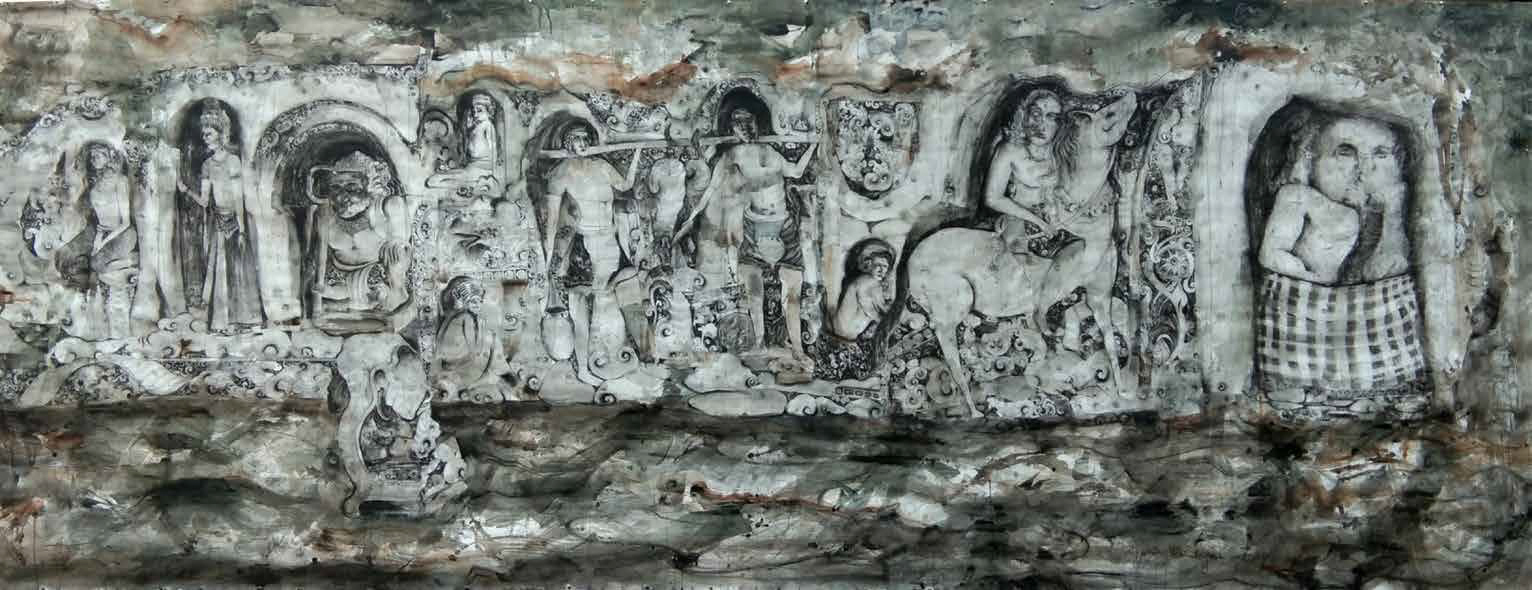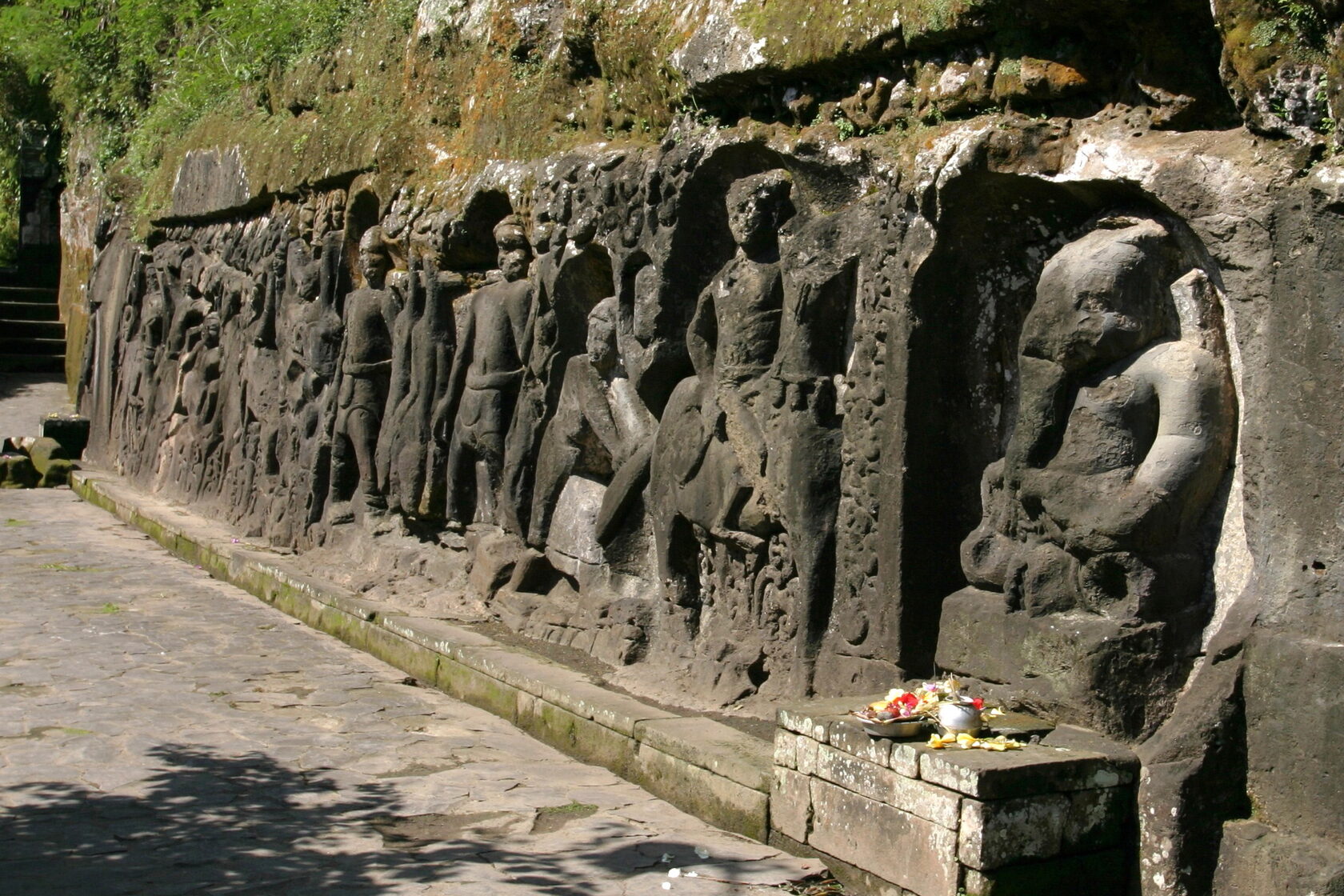Yeh Pulu
Yeh Pulu is an ancient architectural rock complex located near Ubud, near the famous Goa Gajah. This unique monument of ancient Indonesian culture is an important historical and archaeological site in Bali.
Yeh Pulu (Yeh Pulu) is an ancient cliff-side complex located in the village of Bedulu, which once served as the capital of the Pejeng kingdom. Dating back to the mid or late 14th century, it is one of the most captivating archaeological sites on Bali, situated near Ubud and close to the famous Goa Gajah cave.
Name and History
The word “Yeh” means “spring” or “source,” while “Pulu” can mean either “stone rice” or “water container.” The complex was discovered thanks to an ancient spring that has existed here since time immemorial. Yeh Pulu consists of two main elements: a 26.5-meter bas-relief carved into a limestone cliff and a small temple. The bas-relief depicts scenes of daily life and, according to researchers, was carved by a single master artisan, likely a local resident.
Description of the Bas-Relief
The bas-relief begins with a figure of a stone youth welcoming visitors with an upraised hand, followed by five main scenes. In the first, a man carries containers on a pole—perhaps water or palm wine—next to a high-status woman who may be a priestess, outlined by what might be a mandala. Another woman peeks out from a doorway, as if inviting onlookers to glimpse the past.
The second scene shows a seated woman conversing with a man holding a hoe, with small monkeys beneath her seat. A monk is seated off to the side, accompanied by a small altar, indicating his sacred role.
The third scene portrays a wild boar hunt, with three hunters attacking the animal while a horseman observes. In the upper right, two people face each other, one offering a jug to the other, though the meaning of this detail remains unknown.
In the fourth scene, people carry the carcasses of hunted animals, accompanied by a noble-looking rider. A woman tries to hold the horse’s tail, but the rider seems not to notice.
The fifth scene features the Hindu deity Ganesha, set within a niche in the cliff, with an offering altar in front. Visitors must wear a sarong here, due to its sacred significance. At the end of the bas-relief, there is a small shelter used by the site’s caretaker for meditation and rest.
The Miniature Temple
Directly opposite the bas-relief is a small temple complex. It includes three moss-covered pillars adorned with carved patterns, decorated during festivals. The temple features traditional Balinese gates, a small building with a black thatched roof and orange walls, and a table covered in poleng—a ritual black-and-white checkered cloth—used for offerings.
Visitor Tips
Visitors are required to wear a sarong (available for rent on-site). The best time to visit Yeh Pulu is in the morning or evening to avoid the midday heat. Take your time exploring the bas-relief and enjoy the quiet atmosphere of this unique site.
Why Visit Yeh Pulu
Yeh Pulu is not only an important historical landmark but also a place where you can sense the spirit of ancient Bali. Its remarkable cliff carvings bridge the past and present, while its tranquil setting amid rice fields offers an atmosphere of seclusion and harmony. For anyone seeking to delve deeper into the island’s heritage, Yeh Pulu is a must-visit destination.
Name and History
The word “Yeh” means “spring” or “source,” while “Pulu” can mean either “stone rice” or “water container.” The complex was discovered thanks to an ancient spring that has existed here since time immemorial. Yeh Pulu consists of two main elements: a 26.5-meter bas-relief carved into a limestone cliff and a small temple. The bas-relief depicts scenes of daily life and, according to researchers, was carved by a single master artisan, likely a local resident.
Description of the Bas-Relief
The bas-relief begins with a figure of a stone youth welcoming visitors with an upraised hand, followed by five main scenes. In the first, a man carries containers on a pole—perhaps water or palm wine—next to a high-status woman who may be a priestess, outlined by what might be a mandala. Another woman peeks out from a doorway, as if inviting onlookers to glimpse the past.
The second scene shows a seated woman conversing with a man holding a hoe, with small monkeys beneath her seat. A monk is seated off to the side, accompanied by a small altar, indicating his sacred role.
The third scene portrays a wild boar hunt, with three hunters attacking the animal while a horseman observes. In the upper right, two people face each other, one offering a jug to the other, though the meaning of this detail remains unknown.
In the fourth scene, people carry the carcasses of hunted animals, accompanied by a noble-looking rider. A woman tries to hold the horse’s tail, but the rider seems not to notice.
The fifth scene features the Hindu deity Ganesha, set within a niche in the cliff, with an offering altar in front. Visitors must wear a sarong here, due to its sacred significance. At the end of the bas-relief, there is a small shelter used by the site’s caretaker for meditation and rest.
The Miniature Temple
Directly opposite the bas-relief is a small temple complex. It includes three moss-covered pillars adorned with carved patterns, decorated during festivals. The temple features traditional Balinese gates, a small building with a black thatched roof and orange walls, and a table covered in poleng—a ritual black-and-white checkered cloth—used for offerings.
Visitor Tips
Visitors are required to wear a sarong (available for rent on-site). The best time to visit Yeh Pulu is in the morning or evening to avoid the midday heat. Take your time exploring the bas-relief and enjoy the quiet atmosphere of this unique site.
Why Visit Yeh Pulu
Yeh Pulu is not only an important historical landmark but also a place where you can sense the spirit of ancient Bali. Its remarkable cliff carvings bridge the past and present, while its tranquil setting amid rice fields offers an atmosphere of seclusion and harmony. For anyone seeking to delve deeper into the island’s heritage, Yeh Pulu is a must-visit destination.

History of Discovery
When children told the adults about their discovery, local residents began clearing the spring. Underneath the sand, they found a stone bowl into which the water flowed. The work continued until they uncovered an ancient bas-relief adorned with mysterious images. Restoration efforts involved Dutch archaeologists, who in 1949 added a stone trough above the wall to divert rainwater and protect the bas-relief from damage. A significant contribution to the study of Yeh Pulu was made by the Dutch professor August Johan Bernet Kempers, who described the complex in his book Monumental Bali.
The Legends of Yeh Pulu
The site is surrounded by many legends, each adding its own layer of mystery.
Legend of Krishna
The figure of the youth with an upraised hand at the entrance to the bas-relief is believed by some historians to represent the young Krishna. The raised hand symbolizes the moment he lifts Mount Govardhan to shield farmers from the wrath of the rain god Indra. According to the legend, Krishna persuaded the people to stop worshipping Indra, provoking his anger and triggering torrential rains. Krishna then held up the mountain like a giant umbrella, protecting the people and their harvest. Ultimately, Indra admitted defeat, and Krishna came to symbolize power and protection.
Legend of the King of Bedulu
Another legend centers on the king of the ancient Kingdom of Bedulu. It is said that during meditation, he could remove his head as a gesture of reverence before the gods and then reattach it. One day, however, his head slipped from his hands, fell into a river, and drifted away. To save the king, his subjects cut off the head of a passing boar and replaced his lost head with it. Intriguingly, a mysterious statue near the village still shows a partially detached head. The village name “Bedulu (Beda Hulu)” translates as “headless.”
Temple and Monastic Cells
Next to the water source are small temples and monastic cells that archaeologists believe date back to the 14th century. This area served as a retreat for prayer and meditation among ancient monks, who could draw inspiration from the images on the bas-reliefs.
When children told the adults about their discovery, local residents began clearing the spring. Underneath the sand, they found a stone bowl into which the water flowed. The work continued until they uncovered an ancient bas-relief adorned with mysterious images. Restoration efforts involved Dutch archaeologists, who in 1949 added a stone trough above the wall to divert rainwater and protect the bas-relief from damage. A significant contribution to the study of Yeh Pulu was made by the Dutch professor August Johan Bernet Kempers, who described the complex in his book Monumental Bali.
The Legends of Yeh Pulu
The site is surrounded by many legends, each adding its own layer of mystery.
Legend of Krishna
The figure of the youth with an upraised hand at the entrance to the bas-relief is believed by some historians to represent the young Krishna. The raised hand symbolizes the moment he lifts Mount Govardhan to shield farmers from the wrath of the rain god Indra. According to the legend, Krishna persuaded the people to stop worshipping Indra, provoking his anger and triggering torrential rains. Krishna then held up the mountain like a giant umbrella, protecting the people and their harvest. Ultimately, Indra admitted defeat, and Krishna came to symbolize power and protection.
Legend of the King of Bedulu
Another legend centers on the king of the ancient Kingdom of Bedulu. It is said that during meditation, he could remove his head as a gesture of reverence before the gods and then reattach it. One day, however, his head slipped from his hands, fell into a river, and drifted away. To save the king, his subjects cut off the head of a passing boar and replaced his lost head with it. Intriguingly, a mysterious statue near the village still shows a partially detached head. The village name “Bedulu (Beda Hulu)” translates as “headless.”
Temple and Monastic Cells
Next to the water source are small temples and monastic cells that archaeologists believe date back to the 14th century. This area served as a retreat for prayer and meditation among ancient monks, who could draw inspiration from the images on the bas-reliefs.
Yeh Pulu is located here
